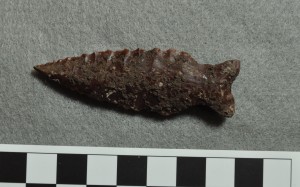
The oldest radiocarbon date archeologists have associated with an artifact in Arkansas is 8720+/- 30 which was derived from a sample of charred wood nearby this Hempstead point from Breckenridge Rockshelter in Carroll county Arkansas. This Hempstead point is currently the oldest dated point form from a rockshelter in Arkansas.
Hempstead points functioned as both knives and spear points. They date to the Early Archaic Period, which began around 12,000 years ago. The only older points found in Arkansas date to the Paleoindian Period. The oldest known point type in the Paleoindian period is called a Clovis point. Clovis points are found across North America and they are common in the Ozarks but so far we do not have a geochemical date for a Clovis point in Arkansas. Clovis points are rarely found in bluff shelters in the midcontinent, however, a point derived from Clovis known as Dalton points which date to the Late Paleoindian period are commonly in found in rockshelters and caves across the midcontinent and are especially common in the Ozarks. The Hempstead point pictured here resembles the Dalton point type based on the serrations and flaking pattern, however, it dates to a later time interval than do Dalton points as we learned from the excavation at Breckenridge Rockshelter.

The excitement of this point lies in the fact that it is now radiocarbon dated. For artifacts to be dated they must be found in a cultural context closely associated with burned rock, or charred bone or plant remains. That context could be a hearth, a burial, a house post, a hearth or some other construction made by people. This context must be relatively undisturbed. Stone tools and the waste from making or maintaining them can be directly dated if burned. The technique used for this direct dating of stone is called Thermoluminescence. The most common geochemical dating technique in archeology and the one used to date the Hempstead point is called radiocarbon dating. Radicarbon dating requires a piece of organic material or burned bone. The sample of organic material or burned bone can be sent to a lab where physicists count the number of carbon 14 atoms remaining in the material after death to determine the age of the sample.
 The Hempstead point pictured above was found deep below the surface of Breckenridge Rockshelter resting on the bedrock of the shelter. In a small area under a piece of rock that had fallen from the roof of the shelter, excavators discovered a deposit of ash with stone tool debris, shell, and animal bone. Nearby was a hearth containing charcoal and near this area was the Hempstead point. Charcoal from the hearth was sent to a lab to be dated. The association between the point and the hearth is spatially ideal. Because both objects were sitting on bedrock, close together, and sealed under a piece of rock from a roof fall episode, it is likely they were left there at the same time and have not been disturbed since. The radiocarbon age obtained from wood charcoal 8720+/- 30 associated with the Hempstead point provides a calendar age of about ca. 9700–9550 years and there is a lesser possibility of the date being 9850 years before present for this Hempstead point. The calendar age can be calculated by examining the most current calibration curve Intcal 20 pictured here that Paula Reimer and her team have recently published in the journal Radiocarbon.
The Hempstead point pictured above was found deep below the surface of Breckenridge Rockshelter resting on the bedrock of the shelter. In a small area under a piece of rock that had fallen from the roof of the shelter, excavators discovered a deposit of ash with stone tool debris, shell, and animal bone. Nearby was a hearth containing charcoal and near this area was the Hempstead point. Charcoal from the hearth was sent to a lab to be dated. The association between the point and the hearth is spatially ideal. Because both objects were sitting on bedrock, close together, and sealed under a piece of rock from a roof fall episode, it is likely they were left there at the same time and have not been disturbed since. The radiocarbon age obtained from wood charcoal 8720+/- 30 associated with the Hempstead point provides a calendar age of about ca. 9700–9550 years and there is a lesser possibility of the date being 9850 years before present for this Hempstead point. The calendar age can be calculated by examining the most current calibration curve Intcal 20 pictured here that Paula Reimer and her team have recently published in the journal Radiocarbon.
Reimer, P., Austin, W., Bard, E., Bayliss, A., Blackwell, P., Bronk Ramsey, C., . . . Talamo, S. (2020). The IntCal20 Northern Hemisphere Radiocarbon Age Calibration Curve (0–55 cal kBP). Radiocarbon, 62(4), 725-757.